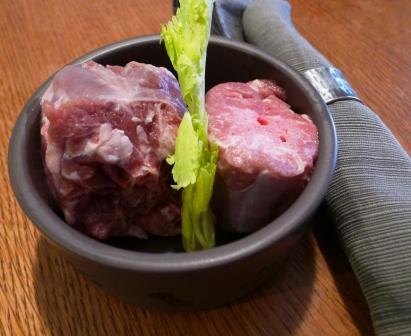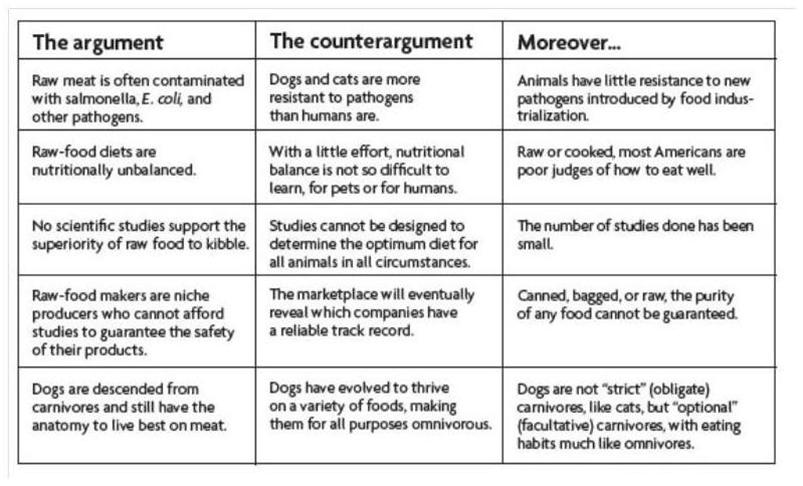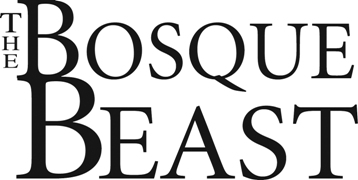
seeing red
The idea makes perfect sense to anyone who’s watched a bit of Animal Planet: Dogs and cats evolved by killing other animals and chomping them on the spot, fur, bones, and all. They love chasing rodents and gnawing bones. So pets should thrive on a diet of raw meat, right?
Definitely so, according to a growing number of pet owners who ask themselves just how and why cans and bags became the normal way to feed animals. Breathless testimony from other pet owners only confirms that nature’s way is best. But ask a veterinarian about it, and the weight of medical research will knock you right back down to earth.
Raw meat is full of dangerous bacteria, veterinarians warn. Raw diets lack necessary nutrients, and cannot possibly be as safe, balanced, complete, and nutritionally sound as a scientifically tested kibble—which sends many well-intentioned pet owners scampering with tail tucked between legs.
Veterinarians’ arguments have not, however, slowed the tide of new products winning shelf space everywhere from specialty shops to mass merchandisers: organic, grainfree, hormone-free, or otherwise “natural” pet foods, including sometimes now a freezer case full of raw.
Pet food has become a retail battleground, making up the largest part of the record $51 billion we spent on pets in 2011, according to the American Pet Products Association. Significantly, most categories of pet products continued to grow despite the recession.
It’s no wonder a topic as mundane as dog chow can provoke such a startling degree of passion on both sides. Converts—who probably make up less than 3 percent of pet owners—swear that their animals have been transformed by eating what nature intended for them.
“Not only are the dogs healthier than they’ve ever been,” says Marci Blaze, a Corrales resident who used to spend thousands treating breed-specific afflictions, “but we also never worry about weight management. Their coats are shiny, they have little to no flatulence, and their waste is minor and turns to powder. In the long run, it costs a great deal less to keep them healthy with a raw diet,” she says of her large mastiffs, “than to feed them processed food, no matter how high quality.”
Recite such testimony to a veterinarian, however, and you may hear a very loud sigh. “Diet pills, ads on TV, do you believe any of that?” says Michael Riegger, chief of staff at Northwest Animal Clinic in Albuquerque. “Truth is not what’s at stake here. It’s marketing. The most competitive part of grocery stores is pet food—the most competitive part of the store.” Riegger fumes over what he calls “myth-information” being circulated about the supposed dangers of commercially available pet food.
It’s Really About Kibble
Indeed, you won’t get far into any debate about feeding raw—whether homemade, popularized by a book, or commercially prepared—without also debating the vices and virtues of kibble and cans. Many people remember a time or place when cats and dogs lived on table scraps and whatever vermin they could catch. In many countries, it’s still common to treat pets from the butcher, not the box. And the long tradition of feeding raw meat to “performance” dogs, such as sled dogs and racing Greyhounds, supports the idea that raw food is a more natural return to a traditional way of life.
The same note was struck by Ian Billinghurst, an Australian veterinarian who created the popular BARF diet (“biologically appropriate raw food,” often shortened to “bones and raw food”). Claiming that his prescription of raw whole foods with no cooked grains is most appropriate for dogs and cats from an evolutionary standpoint, he accused veterinarians of profiting from the very diseases caused by commercial pet food.
American raw-food advocates have picked up the same banner against industry and veterinary science. “Vet clinics do brisk business every single day treating the diseases and chronic conditions that arise when cats and dogs are fed inferior commercial diets they were never anatomically and physiologically designed to live on,” says Lisa McKitrick, co-owner of Boofy’s Best for Pets. “When it comes to opinions on how to feed carnivores, I’m going to listen to Mother Nature… [Her] research isn’t funded by corporations trying to justify the use of subpar, biologically inappropriate ingredients in the name of profitability.”
Not surprisingly, veterinarians bristle at accusations of being in the same boat with industry. Dr. Riegger says veterinarians endorse certain products not because they benefit, but because these diets have been subjected to extensive peer-reviewed research. “It’s a complicated business—it’s more complicated than the tax code— and someone who thinks they can do a better job than a commercial company…”
The so-called guaranteed analysis on food package labels guarantees nothing, he notes. Pet food producers are not required to tell the whole truth about what is in their products. Even the best companies have been caught with contamination or deficiencies, which makes raw products even more suspect.
“Raw foods are produced by niche companies, and these products are not available for public and private assessment,” says Riegger. The producers have no data and no studies, so “the food can come to you rancid. Do these companies have digestibility studies? How can they guarantee that it doesn’t have bacteria growing in it?” Studies that have been done on raw diets universally condemn them, he notes. “And refereed publications have no connection to commercial interests.”

Riegger says he has seen many cases of dogs with “dull coats, vitamin deficiencies—we had four cases recently where dogs had orthopedic problems, another with a thiamine deficiency. Why? Raw foods.” Veterinarian Christine Wilson of Albuquerque, who feeds raw to her own dogs, counters that she has seen tons of problems resulting from commercial diets: joint and dental maladies, obesity, allergies. “If you think commercial food doesn’t have problems, you’re kidding yourself.”
It’s no wonder the question of what to feed continues to befuddle consumers. The insinuations and absolutes quickly escalate into a much thornier debate about what is true and who is trustworthy. For consumers with a deep distrust of corporate America, scientific data has become just another weapon that can be purchased by the highest bidder. For rationalists, scientific methodology remains the only antidote to marketplace hype.
Lost in the contest are the voices of moderation. Dr. Wilson, who practices both conventional and Oriental medicine, says she does not recommend raw diets for all animals, all the time. But she also thinks conventional veterinarians are overly driven by a need for control. They feel helpless to dictate an important aspect of animal care, “so they blame it on the raw food.”
As for commercial feed, scientific studies that have been done “are not, in my opinion, adequate to study what you have to do to make a dog healthy,” she says. “They’re studies of how to keep a dog alive.”
Wilson’s own practice includes educating pet owners on how to prepare a diet appropriate to an animal’s age, activity level, and condition, whether raw or cooked. “You learned to feed yourself, so you just need to learn the [nutrient] proportions. What would you do if there was an apocalypse and there was no commercial pet food anymore?”
Of course, many people struggle just to feed themselves well, much less their pets. Daniel Levenson, who operates the Southwest Veterinary Medical Center in Corrales, says a raw food diet certainly could be well balanced nutritionally, if it were done by a trained nutritionist. But most veterinarians can’t justify the trouble, expense, and risks of feeding raw when “clinical studies have shown there’s no health benefits that we can prove.”
Levenson adds that he has seen some animals improve with the switch to a raw diet. “I can’t discount that,” he says of patients treated by alternative therapists in his practice. “Problem is, you can’t tell if it’s the raw diet that’s doing it.” It’s possible the pet was eating the wrong kind of diet before. Or that the change is unrelated to diet. For his own dogs, Levenson chooses to feed a high-quality dry food, “and they do just fine.”
It’s Really About Us
And here lies the biggest obstacle to winning any argument, for or against raw diets: No one can dispute that cats and dogs have continued to multiply over the centuries regardless of what they were eating—freshly killed rabbits, leftover French fries, or Alpo. It’s a tossup whether they are healthier being half-starved in poor communities or overfed in rich ones, and it’s not always clear what makes them ill. Since dogs and cats have evolved together with humans for centuries, our ills are their ills, which today means cancer, heart disease, joint problems, and terrible teeth rather than starvation, attack, plague, or exposure. As debate continues to rage about what humans require to be healthy, discussion about what to feed our pets ends up being just as confused and contradictory.
The solution is not as simple as deciding to favor science or emotion. As Americans, we have been trained to express our values and beliefs through consumption, by inhabiting a “market niche.” Whether you opt for discount kibble, Science Diet, or grass-fed, organic raw-meat patties speaks more to your self-perception than any evidence you might have about the effect on your pets.
“The people who love raw food are the same people who buy vegan or organic,” says Levenson. “It doesn’t matter if they can prove it. They’re very passionate about it, and you can’t tell them any different.” Feeding raw has become, in the marketplace of ideas, part of a niche movement to live sustainably, buy from small local producers, resist corporate products, and eat organic whole foods as part of an expression about what is right and wrong with humankind.
The battle over this much larger “truth” cannot be won by either side—on the topic of dogs any more than on God. Since the one thing we do know is that our pets will eat what they are given and suffer the consequences, the sensible solution seems to be a little of everything and nothing to extremes—just as for humans. But in pet health, as in human affairs, moderation is a consensus that is easily reached and hardly ever practiced.

